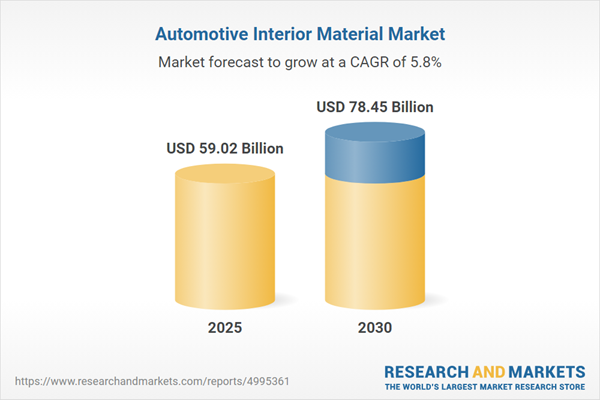Speak directly to the analyst to clarify any post sales queries you may have.
The automotive interior materials market is entering a transformative phase, shaped by heightened sustainability mandates, emerging digital technologies, and evolving consumer preferences. Senior decision-makers navigating this landscape require actionable insights to optimize material sourcing, drive innovation, and remain resilient amid regulatory and trade challenges.
Market Snapshot: Automotive Interior Materials Market Growth Trajectory
The Automotive Interior Material Market grew from USD 55.84 billion in 2024 to USD 59.02 billion in 2025, with expectations to reach USD 78.45 billion by 2030 at a CAGR of 5.82%. Market evolution is propelled by OEMs opting for advanced synthetics, eco-friendly polymers, recycled materials, and innovative design architectures, all in response to regulatory requirements and shifting user expectations.
Scope & Segmentation
- Material Types: Fabric (Non-Woven Fabric, Woven Fabric), Leather (Natural Leather, Synthetic Leather), Metals (Aluminum, Magnesium, Steel), Plastics & Composite Materials (Carbon Fiber, Foam, Nylon, Polypropylene Composite, Polyurethane, Polyvinyl Chloride), Wood Trim (Engineered Wood, Real Wood)
- Components: Carpet & Headliners, Console (Armrest Console, Center Console), Door Panels (Front Door Panel, Rear Door Panel), Instrument Panel, Roof Liners, Seats (Front Seats, Rear Seats), Steering Wheels
- Vehicle Types: Commercial Vehicles (Heavy, Light), Passenger Vehicles (Hatchback, Sedan, SUVs)
- Sales Channels: Aftermarket, OEM
- Distribution Channels: Offline (Direct Sale, Distributor Network), Online
- Propulsion Types: Battery Electric Vehicles, Hybrid Electric Vehicles, Internal Combustion Engine Vehicles
- Regions: Americas (United States, Canada, Mexico, Brazil, Argentina, Chile, Colombia, Peru), Europe, Middle East & Africa (United Kingdom, Germany, France, Russia, Italy, Spain, Netherlands, Sweden, Poland, Switzerland, United Arab Emirates, Saudi Arabia, Qatar, Turkey, Israel, South Africa, Nigeria, Egypt, Kenya), Asia-Pacific (China, India, Japan, Australia, South Korea, Indonesia, Thailand, Malaysia, Singapore, Taiwan)
- Companies Covered: 3M Company, Adient PLC, Asahi Kasei Corporation, AURIA SOLUTIONS USA, INC., Bader GmbH & Co. KG, BASF SE, Boxmark Leather Holding GmbH & Co KG by H. Schmidt Holding GmbH, Continental AG, Covestro AG, Daimler Truck AG, DK-SCHWEIZER LEATHER SDN BHD, Dräxlmaier Group, FORVIA Group, Freudenberg SE, Haartz Corporation, Hayashi Telempu Corporation, Hitkari Hitech Private Limited, Kuraray Co., Ltd., Lear Corporation, Magna International Inc., Recticel S.A., Seiren Co., Ltd., The Dow Chemical Company, Thermoflex Corporation, Toyota Motor Corporation, Trinseo PLC, Wollsdorf Leder Schmidt & Co Ges.m.b.H., Yanfeng International Automotive Technology Co. Ltd.
Key Takeaways for Senior Leaders
- Innovative material adoption is driving differentiation, utilizing next-generation synthetics, composites, and engineered wood to enhance comfort, acoustics, and aesthetics.
- Heightened focus on sustainability is prompting OEMs and suppliers to integrate recycled fibers, biodegradable polymers, and responsibly sourced timber within interior components.
- Electrification and digital customization trends are shaping new requirements for interiors, with increased emphasis on embedded sensors, ambient lighting, and flexible design architectures.
- Collaboration has intensified between material scientists, automotive designers, and system integrators to accelerate the joint development of multifunctional materials with acoustic, weight, and comfort benefits.
- Digital solutions—such as cloud-based material libraries and virtual reality sample inspection—are streamlining the selection and prototyping process for automotive interiors.
Tariff Impact: Navigating US Market Changes
Proposed United States tariffs in 2025 are expected to impact sourcing strategies and cost structures for core interior components, such as polyurethanes, textiles, and select wood trims. In response, vehicle manufacturers are evaluating nearshoring, investing in joint-ventures within duty-favored zones, and seeking tariff-exempt or alternative material formulations. These measures are supporting industry resilience but are also driving further regional production realignments and risk management initiatives.
Methodology & Data Sources
Research utilizes a rigorous multi-stage process, including primary interviews with industry executives, tier-one suppliers, and technical specialists, as well as secondary data from technical journals and regulatory sources. Data triangulation across interviews, published standards, and laboratory results ensures reliable findings and an empirical basis for recommendations. Advisory panel reviews further validate assumptions and highlight emerging risks.
Why This Report Matters
- Enables leadership teams to anticipate regulatory shifts and sustainability trends shaping the global automotive interior materials market.
- Supports strategic sourcing, portfolio refinement, and go-to-market planning across multiple regions, segments, and technologies.
- Equips decision-makers with competitive intelligence and actionable insights for risk management, digital transformation, and supply chain optimization.
Conclusion
Sustainability, digitization, and regulatory complexity are reshaping how stakeholders create value from interior materials in automotive markets. Strategic alliances, investment in innovation, and agile supply networks will distinguish leaders as the industry adapts to ongoing disruption.
Additional Product Information:
- Purchase of this report includes 1 year online access with quarterly updates.
- This report can be updated on request. Please contact our Customer Experience team using the Ask a Question widget on our website.
Table of Contents
3. Executive Summary
4. Market Overview
7. Cumulative Impact of Artificial Intelligence 2025
Companies Mentioned
The companies profiled in this Automotive Interior Material market report include:- 3M Company
- Adient PLC
- Asahi Kasei Corporation
- AURIA SOLUTIONS USA, INC.
- Bader GmbH & Co. KG
- BASF SE
- Boxmark Leather Holding GmbH & Co KG by H. Schmidt Holding GmbH
- Continental AG
- Covestro AG
- Daimler Truck AG
- DK-SCHWEIZER LEATHER SDN BHD
- Dräxlmaier Group
- FORVIA Group
- Freudenberg SE
- Haartz Corporation
- Hayashi Telempu Corporation
- Hitkari Hitech Private Limited
- Kuraray Co., Ltd.
- Lear Corporation
- Magna International Inc.
- Recticel S.A.
- Seiren Co., Ltd.
- The Dow Chemical Company
- Thermoflex Corporation
- Toyota Motor Corporation
- Trinseo PLC
- Wollsdorf Leder Schmidt & Co Ges.m.b.H.
- Yanfeng International Automotive Technology Co. Ltd.
Table Information
| Report Attribute | Details |
|---|---|
| No. of Pages | 187 |
| Published | November 2025 |
| Forecast Period | 2025 - 2030 |
| Estimated Market Value ( USD | $ 59.02 Billion |
| Forecasted Market Value ( USD | $ 78.45 Billion |
| Compound Annual Growth Rate | 5.8% |
| Regions Covered | Global |
| No. of Companies Mentioned | 29 |









